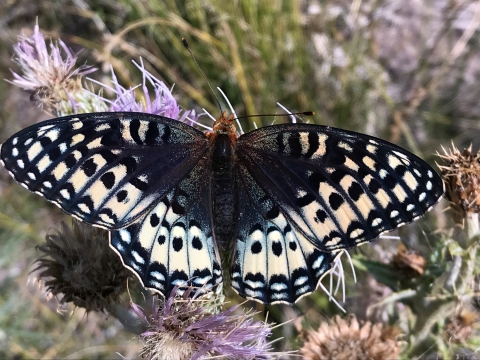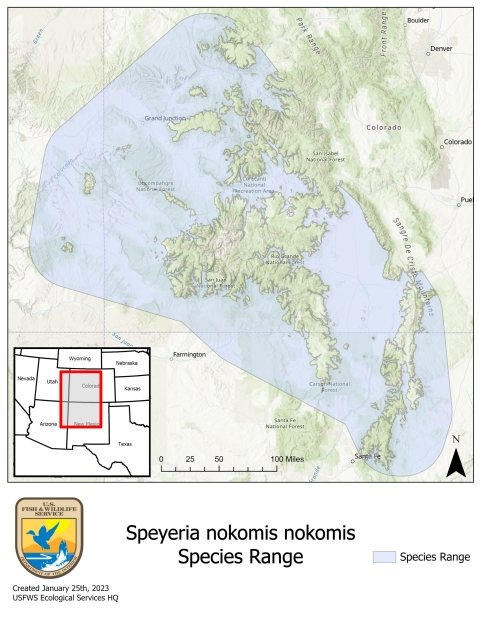DENVER — Today, the U.S. Fish and Wildlife Service is announcing a final rule to list a subspecies of silverspot butterfly (Speyeria nokomis nokomis) as threatened under the Endangered Species Act. This action follows a public comment period on the draft rule and the completion of a peer-reviewed Species Status Assessment. While the silverspot butterfly is not in immediate danger of extinction, the best available scientific information indicates that it is likely in danger of extinction in the foreseeable future.
Although there are various types of "silverspot" butterflies, this particular subspecies is documented in ten populations across southwestern Colorado, eastern Utah, and northern New Mexico, at elevations ranging from 5,200 to 8,300 feet. A relatively large butterfly with up to a 3-inch wingspan, silverspot butterflies are known for distinctive silvery-white spots on the underside of their wings. On their upper side, females have a cream or light-yellow coloring with brown or black, and males have a bright orange upper side.
The silverspot requires moist, open meadows with vegetation for shelter. Herbaceous plants are also crucial as nectar sources, which provide energy to adults for mating and flying. This butterfly has an annual life cycle and lays eggs on, or immediately next to, the bog violet (Viola nephrophylla/V. sororia var. affinis) that the larvae feed on exclusively. The eggs hatch approximately two weeks after being laid in September, and the larvae immediately drink or absorb water before going dormant until May. When the bog violets flower in May, the larvae feed on them exclusively through July. They then form a chrysalis and metamorphize into adult butterflies, living for about 45 days to lay their eggs in September.
The Service completed a comprehensive, peer-reviewed SSA to gather the best scientific and commercial data available and evaluated the threats to this subspecies, an updated version of the SSA is available today. More information about SSAs can be found here. Threats facing the silverspot butterfly include future effects from climate change climate change
Climate change includes both global warming driven by human-induced emissions of greenhouse gases and the resulting large-scale shifts in weather patterns. Though there have been previous periods of climatic change, since the mid-20th century humans have had an unprecedented impact on Earth's climate system and caused change on a global scale.
Learn more about climate change in combination with habitat loss and fragmentation, incompatible livestock grazing, human alteration of natural hydrology, and genetic isolation. The Service is not designating critical habitat for this species due to the increased threat of collection and trade for rare butterflies.
With the rule to list this species as threatened, the Service has also developed an accompanying 4(d) rule. This rule tailors the conservation of the species with balanced land management to allow continued acceptable land uses. The rule states that incidental take from the following activities is exempt if the activities are done in a manner compatible with conserving the silverspot butterfly and bog violet: livestock grazing, haying or mowing, prescribed burning, brush control, noxious weed control, fence or structural maintenance, and maintenance to existing utility transmission corridors.
The final rule to list the silverspot butterfly as a threatened species and the accompanying 4(d) rule will be published tomorrow in the Federal Register and is available for public inspection today in the Reading Room.
Today's announcement comes as the Service celebrates the 50th Anniversary of the Endangered Species Act of 1973. The ESA provides a critical safety net for fish, wildlife, and plants by preventing the extinction of hundreds of imperiled species, promoting the recovery of many others, and conserving the habitats upon which they depend. Endangered species recovery is complex and challenging work, often requiring substantial time and resources. Species today face ongoing threats such as habitat loss and new threats, including climate change and wildlife trafficking. Nevertheless, we have a continued commitment as a nation to protect imperiled species.






